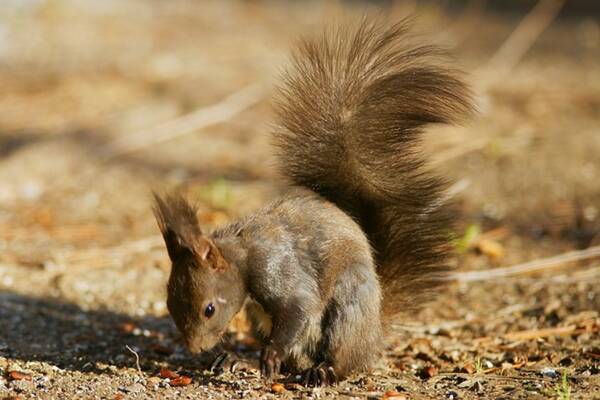Sciuridae
IUCN
LCBasic Information
Feature
A squirrel with a big furry tail that chews pine cones
Distribution and Habitat
Squirrels are widely distributed in the temperate and cold temperate forest ecosystems of the Palearctic, from Iberia and Great Britain in the west to the Kamchatka Peninsula, Sakhalin Island in Russia and Hokkaido in Japan in the east, and to the Mediterranean, the Black Sea, northern Mongolia, and the northwest and northeast regions of China in the south.
Squirrels are mainly distributed in coniferous forests or mixed coniferous and broadleaved forests composed of pine (Pinus), larch (Larix) and spruce (Picea) species. Due to the relatively abundant and stable food source, squirrels can maintain a high population density in mixed coniferous and broadleaved forests, and can use small pieces of woodland in suburban areas or even cities, becoming companion animals.
Appearance
The Eurasian red squirrels distributed in the eastern part of Eurasia have black fur on their backs and white belly in winter, and gray and brownish red fur in summer; while the Eurasian red squirrels distributed in the western part of Eurasia have brownish red fur on their backs all year round. In China, the taiga forests in Northeast China and Xinjiang are the natural distribution range of the Eurasian red squirrels. The more widely distributed squirrels in the broad-leaved forests and mixed coniferous and broad-leaved forests in North China and other places are rock squirrels. Rock squirrels are smaller than Eurasian red squirrels, do not have long tufts of hair on their ears, are grayish yellow in color, and are more likely to move on the ground, especially in rocky areas, hence the name. The chipmunk is also a common squirrel in China's temperate regions. This small animal with black and white vertical stripes on its back spends more time foraging on the ground, often preying
Details
Squirrels, belonging to the family Sciuridae of the order Rodentia, refer to a large class of rodents with fluffy long hair on their tails. There are about 58 genera and 285 species in existence, distributed throughout all continents except Antarctica (introduced species in Oceania). Contrary to most people's impressions, squirrels that live in trees, have big furry tails, and chew pine cones are actually just a small branch of the Sciuridae species. From snow-capped mountains at an altitude of more than 6,000 meters to tropical islands in the Pacific Ocean, from the Western Hemisphere to the Eastern Hemisphere, except for areas near the poles or the driest deserts with extremely harsh climates and extremely simple or even no vegetation, species of the Sciuridae family are active in various terrestrial habitats, and some of them play an extremely important role in the ecosystem.

The earliest known fossils of squirrel species come from the Eocene strata. That was a long time ago, 65 million to 35 million years ago. At that time, dinosaurs had just become extinct, mammals had not yet gained control on land, the Qinghai-Tibet Plateau had not yet become land, Europe and North America were still connected by land, and South America was a huge island. The most primitive squirrels lived in North America, and their morphology was similar to today's flying squirrels. A series of squirrel fossils have been found in the late Eocene strata of North America, which are different from any other squirrels. The unusually rich fossil squirrel species in North America show that the Sciuridae originated in North America in the Eocene, and radiated to all continents outside Oceania in the long years that followed. In this process, species with different shapes and adaptability to various environments evolved. Among the existing rodent squirrel suborder species, the Dormouse family, which is mainly distributed in Eurasia, and the Mountain Beaver family, which is distributed in North America, are closely related to the Sciuridae family. The Sciuridae family is the most well-known member of the squirrel family, and it is also the most widely distributed and diverse group.









